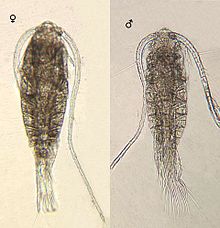| This article needs additional citations for verification. Please help improve this article by adding citations to reliable sources. Unsourced material may be challenged and removed. Find sources: "Leptodiaptomus minutus" – news · newspapers · books · scholar · JSTOR (June 2014) (Learn how and when to remove this message) |
| Leptodiaptomus minutus | |
|---|---|

| |
| Female and male L. minutus | |
| Scientific classification | |
| Domain: | Eukaryota |
| Kingdom: | Animalia |
| Phylum: | Arthropoda |
| Class: | Copepoda |
| Order: | Calanoida |
| Family: | Diaptomidae |
| Genus: | Leptodiaptomus |
| Species: | L. minutus |
| Binomial name | |
| Leptodiaptomus minutus (Lilljeborg in Guerne & Richard, 1889) | |
Leptodiaptomus ashlandi is a calanoid copepod zooplankton.
Distribution
Leptodiaptomus minutus is found over most of North America north of the 40th parallel and in Greenland and Iceland. It may extend further south in mountainous areas of the East, but appears to be absent from the far western United States. It is found in all the Great Lakes and is particularly abundant in Lake Huron and Lake Michigan
Morphology
Leptodiaptomus minutus adult females are characterized by a two-segmented urosome, metasomal wings that are nearly symmetrical and rounded, and endopods of leg 5 are greatly reduced in size. In adult males, the small lateral spine on the terminal segment of leg 5 is located in the proximal third of the segment, and the right (geniculate) antennule has a slender process on the third to the last segment. This species is the smallest calanoid in the Great Lakes, only Leptodiaptomus ashlandi may overlap its size range. One might determine that the lateral spine on leg 5 of L. minutus is located more in the middle portion of the terminal segment. However, the size of the spine (less than half the width of the exopod terminal segment) would not allow its confusion with Onychodiaptomus sanguineus, Leptodiaptomus sicilis, or Leptodiaptomus siciloides, where the spine is at least as long as the width of the segment. These species are physically similar to other leptodiaptomids (Leptodiaptomus ashlandi, Leptodiaptomus sicilis and skistodiaptomids (Skistodiaptomus oregonensis).
Ecology
Leptodiaptomus minutus are known prey items for a number of native and non-native Great Lakes fishes. They are also prey items for other invertebrate zooplankton. Remains have been found within gut-contents of Mysis diluviana and are trophically below Limnocalanus macrurus.
References
- Mary D. Balcer, Nancy L. Korda & Stanley I. Dodson (1984). "Life history and ecology of the major crustacean species". Zooplankton of the Great Lakes: a guide to the identification and ecology of the common crustacean species. University of Wisconsin Press. pp. 49–109. ISBN 978-0-299-09820-9.
- Hudson, Patrick L., and Lynn T. Lesko. 2003. Free-living and Parasitic Copepods of the Laurentian Great Lakes: Keys and Details on Individual Species. Ann Arbor, MI: Great Lakes Science Center Home Page. http://www.glsc.usgs.gov/greatlakescopepods/MainMenu.php?
- Brian P. O'Malley, David B. Bunnell. 2014. Diet of Mysis diluviana reveals seasonal patterns of omnivory and consumption of invasive species in offshore Lake Michigan, Journal of Plankton Research, Volume 36, Issue 4, July/August 2014, Pages 989–1002, https://doi.org/10.1093/plankt/fbu038
- Doubek, J. P., & Lehman, J. T. (2014). Historical trophic position of Limnocalanus macrurus in lake Michigan. Journal of Great Lakes Research, 40(4), 1027-1032.
| Taxon identifiers | |
|---|---|
| Leptodiaptomus minutus | |
| Diaptomus minutus | |